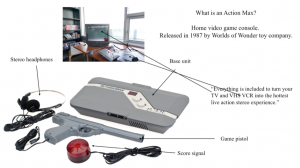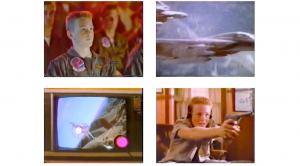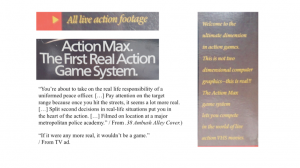Action Max: Notes on a Deictic Dispositif
As a Cinema Studies scholar focusing on analogue video, I was excited to find an old Action Max gathering dust in the wonderful depot Darren Wershler has termed “research collection”. This peculiar 1987 console relies on a special, if not entirely unique technical condition: it uses VHS tapes as its storage medium for live action “gaming” sequences. This leads to a number of bizarre consequences from a gaming point of view, which also make it a fascinating media object to “archaeologise” in toto – that is to say trying to figure out the relation between its intended technical operations, implied discursive formations, and the aesthetic expressions found both on the “outside” (the boxes) and the “inside” (the “games” themselves).
Understanding the logic of the Action Max, then, became the somewhat ambitious aim of my afternoon project, and what follows is as far as I got during the two-three afternoons I had to try making sense of this apparatus. Needless to say, the following notes (adapted from my final presentation) are only seeds for a more substantial research project I intend to undertake.

The Action Max is a video game console whose basic components are a base unit; stereo headphones; a game pistol and a “score signal”. Unlike a regular video game console, the base unit can’t play the actual games, but merely display the number of hits with a counter, and subsequent sound effects (shots and ricochets). The only direct connection between the VCR that plays the games and the base console is an audio cord (seemingly intended to feed an audio signal from the tapes via the base unit to the headphones). The “score signal”, connected to the base unit and attached to the TV with a suction cup, signals the hits by blinking. This rather awkward device seems to be the solution to the Action Max’s main problem, namely that, unlike a regular video/computer game, the information stored on the analogue “game videos” remains entirely unresponsive to the ludic operations that it is intended to generate. In other words: the “games” (pre-recorded linear video sequences) couldn’t care less if you hit or miss: the tape just keeps rolling for 15 minutes or so until the “game” ends (unless you turn it off before that).
 But what tapes. With titles like Sonic Fury and The Rescue of Pops Ghostly, the Action Max should’ve been a hit (no pun). Too bad Worlds of Wonder only had time to release these five titles before they had to file for bankruptcy protection. The image above is the entire corpus of the Action Max, and what hits me (OK, yes pun) is the striking aesthetic consistency of the exterior design. We also find this blond boy pointing his gun at the TV screen on the box of the console and in the 1980s TV commercial in which he plays the ideal Action Max player.
But what tapes. With titles like Sonic Fury and The Rescue of Pops Ghostly, the Action Max should’ve been a hit (no pun). Too bad Worlds of Wonder only had time to release these five titles before they had to file for bankruptcy protection. The image above is the entire corpus of the Action Max, and what hits me (OK, yes pun) is the striking aesthetic consistency of the exterior design. We also find this blond boy pointing his gun at the TV screen on the box of the console and in the 1980s TV commercial in which he plays the ideal Action Max player.
 The ad fuses three diegetic levels: a military briefing room (the boy’s immersive imaginary); the air combat (actual images from the game); and, after a zooming out from the screen-within-the-screen: shots of the boy happily shooting away (idealised images of the gaming situation).
The ad fuses three diegetic levels: a military briefing room (the boy’s immersive imaginary); the air combat (actual images from the game); and, after a zooming out from the screen-within-the-screen: shots of the boy happily shooting away (idealised images of the gaming situation).
 What underlies the transition between the three diegetic levels is a semi-seamless leap between media formats, and it is entirely dependent on the technical conditions of the Action Max itself. In 1987, we couldn’t have moved from a cinematic or videographic image to a game image without noticing it, other than under the very particular conditions of a game that is itself videographic – which is the rare case here, and which the producers of the ad want to highlight.
What underlies the transition between the three diegetic levels is a semi-seamless leap between media formats, and it is entirely dependent on the technical conditions of the Action Max itself. In 1987, we couldn’t have moved from a cinematic or videographic image to a game image without noticing it, other than under the very particular conditions of a game that is itself videographic – which is the rare case here, and which the producers of the ad want to highlight.
 The extent to which the Action Max relies on the unprecedented verisimilitude of its audiovisual content vis-à-vis other then-contemporary games, becomes evident in the discursive elements of its marketing. “The First Real Action Game System”; “This is not two dimensional computer graphics – this is real!!” and so on. We find this on the box of the console, on the back-cover texts for each game, and in the somewhat unfortunate TV ad slogan: “If it were any more real, it wouldn’t be a game.” Given that the price to pay for this videographic verisimilitude is precisely what would make the “game videos” actual video games, namely the possibility to interact with their audiovisual content, the slogan becomes not so much a sales pitch as a finger pointed at the console’s own pitfall. It wants to be so real that it can’t be a game.
The extent to which the Action Max relies on the unprecedented verisimilitude of its audiovisual content vis-à-vis other then-contemporary games, becomes evident in the discursive elements of its marketing. “The First Real Action Game System”; “This is not two dimensional computer graphics – this is real!!” and so on. We find this on the box of the console, on the back-cover texts for each game, and in the somewhat unfortunate TV ad slogan: “If it were any more real, it wouldn’t be a game.” Given that the price to pay for this videographic verisimilitude is precisely what would make the “game videos” actual video games, namely the possibility to interact with their audiovisual content, the slogan becomes not so much a sales pitch as a finger pointed at the console’s own pitfall. It wants to be so real that it can’t be a game.
My tentative conclusion at this early point – which is really more of a working hypothesis – is that the Action Max is best understood from the point of view of an inherent tension between its videographic verisimilitude and its limited ludic operations: between realism and (non-)interactivity. The Action Max is what I would call a deictic dispositif, since it presupposes the most basic and banal operation: a pointing that is entirely pointless beyond the tautological task of gathering points. By dispositif I mean the technically conditioned set of operations that the Action Max prescribes,[1] and also expresses in the console’s discursive and aesthetic elements.
I will look more deeply into the way that the Action Max manifests the two meanings of indexicality that informs film theory (in a simplified appropriation of Charles Sanders Peirce’s semiotics). There is the indexical relation between the videographic image and its referents: a material condition for the console’s realist (cl)aims. There is also the indexical relation between player and game: a micro-ludic dispositif limited to a single deictic operation – pointing at flicker on the screen.[2] If, as Mary Ann Doane suggests, the index is an empty sign whose referent is arbitrary, a vessel to be filled with any given meaning (101), the box design becomes a perfect manifestation of the console’s indexical emptiness. The only constant is the pointing itself, while the games, the TV screens’ content, is not only arbitrary but interchangeable.
 The awkward over-use of deixis in the back-cover texts points in the same direction. But it also points towards an ideologic that underlies the Action Max as a dispositif. To talk about the “ideological effects of the basic Action Max apparatus” (to paraphrase Jean-Louis Baudry) would be to overshoot the target, since the console had very limited cultural impact. That is to say that its actual effect seems to have been limited to the disappointment of the few consumers who were quick to abandon the ship (or submarine, or airplane, or helicopter, it makes little difference). One could, however, talk about a kind of ideologic: underlying principles that prescribe the operations (mirrored by the discursive and aesthetic elements that frame them).
The awkward over-use of deixis in the back-cover texts points in the same direction. But it also points towards an ideologic that underlies the Action Max as a dispositif. To talk about the “ideological effects of the basic Action Max apparatus” (to paraphrase Jean-Louis Baudry) would be to overshoot the target, since the console had very limited cultural impact. That is to say that its actual effect seems to have been limited to the disappointment of the few consumers who were quick to abandon the ship (or submarine, or airplane, or helicopter, it makes little difference). One could, however, talk about a kind of ideologic: underlying principles that prescribe the operations (mirrored by the discursive and aesthetic elements that frame them).
 Separated from the meaning of its scenic content (which, as the box covers already imply, is entirely arbitrary, external to, and unresponsive to the basic ludic operation), the Action Max is a simple signalling system: a flicker appears at pre-recorded moments (signalling “point here”), and the “score signal” flashes with each hit (signalling “you have pointed there”). If there is an ideologic underlying this machine, it is a kind of Fordist-Pavlovian short-circuit of order-and-confirmation, the subject of which is a player whose only symbolic reward is nullified if it exceeds 99, the numerical limit of the counter. No accumulation of gamer’s capital at the micro-ludic assembly-line. The logic of the dispositif is perfectly mirrored by the back-covers, whose over-reliance on indices and imperatives makes for an awkward reading:
Separated from the meaning of its scenic content (which, as the box covers already imply, is entirely arbitrary, external to, and unresponsive to the basic ludic operation), the Action Max is a simple signalling system: a flicker appears at pre-recorded moments (signalling “point here”), and the “score signal” flashes with each hit (signalling “you have pointed there”). If there is an ideologic underlying this machine, it is a kind of Fordist-Pavlovian short-circuit of order-and-confirmation, the subject of which is a player whose only symbolic reward is nullified if it exceeds 99, the numerical limit of the counter. No accumulation of gamer’s capital at the micro-ludic assembly-line. The logic of the dispositif is perfectly mirrored by the back-covers, whose over-reliance on indices and imperatives makes for an awkward reading:
“Over there! Behind the couch. Look out! Upstairs – the attic is full of ‘em” (The Rescue of Pops Ghostly). “Take’er down. […] Speed through the murky depths of oceans […] Surface! Surface! Up There. […] Dead on! […] Return fire!” (Hydrosub: 2021). “Prepare for action […]. “Watch out! […] Above you […]. Lock-on. Fire! Fire!” (Sonic Fury). And so on. One comes to think of Gilles Deleuze and Félix Guattari’s provocative take on language, one that in this case not so much determines the machine as it is determined by it, by its technical limitations.
“The elementary unit of language – the statement – is the order-word. […] Language is made not to be believed but to be obeyed, and to compel obedience. […] Information is only the strict minimum necessary for the emission, transmission, and observation of orders and commands. One must be informed just enough not to confuse ‘Fire!’ with ‘Fore!’” (84)
If the micro-ludic signalling system that governs the Action Max renders language obsolete, the residual language that frames the system is a mere reflection of the same signaletic logic. Everywhere, there are order-words. Since obedience to “Fore” is already determined by the Action Max dispositif (no possibility to influence the automatic movement within the pre-recorded space of an analogue “game video”), the only confusion is inherent to “Fire” itself. The Pavlovian flicker that conditions you to pull the trigger turns out to be giving you mixed signals. Sometimes the targets happen to be civilians. The game pistol registers the difference: there is apparently a change in the flicker, invisible to the human eye. For the human eye, however, any of the flickering patterns are perceived as random noise that disturbs the field of vision and obscures the status of the figures underneath. The game finally becomes a kind of lottery. Hit one flickering circle and you’re awarded; hit another and you lose a point. There is a double bind inscribed into the ideologic at work here: at seemingly random moments, you are punished for obeying the one and only order that the dispositif has conditioned you to execute.
Works Cited
Baudry, Jean-Louis. “Ideological Effects of the Basic Cinematographic Apparatus.” Film Quarterly, vol. 28, no. 2, Winter, 1974-1975, pp. 39-47.
Deleuze, Gilles and Félix Guattari. A Thousand Plateaus. Continuum, 2010.
Doane, Mary Ann. The Emergence of Cinematic Time: Modernity, Contingency, the Archive. Harvard University Press, 2002.
[1] See Baudry.
[2] As Darren Wershler pointed out during the seminars, the technical conditions of the game pistol, which receives rather than emits signaletic information, signifies a reversal of terms whereby the game is actually pointing at the player rather than the other way around. This is a significant point which will have to be developed to understand the Action Max’s dispositif.